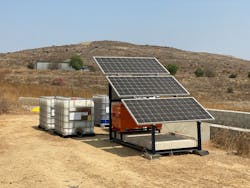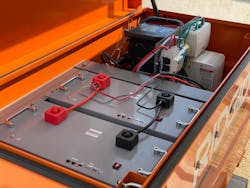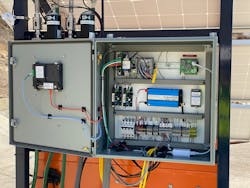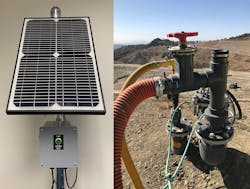The term “off-grid” is often associated with those who camp, or even live, in remote locations without access to the electrical grid and other utilities. In this context, going off-grid can be a choice to demonstrate self-sufficiency and reduce one’s environmental impact. However — for companies and municipalities with power generation, water treatment and other support equipment in remote locations — monitoring and controlling off-grid assets can be a challenging necessity.
Off-grid is not necessarily all that far away from civilization, either. There are many instances of process equipment installed on-site at a large facility, but not easily connectable to power or networking utilities. Reducing the amount of electrical wiring minimizes installation costs and it can also reduce the potential for fire or explosions at some locations. Whether the off-grid location is near or far, users must often perform costly installations to achieve connectivity.
Today, several technologies have converged to make off-grid connectivity a much more practical possibility and, more than ever, end users want to gather data as part of industrial internet of things (IIoT) initiatives. Solar panels, durable batteries, wireless networking and efficient electronics can overcome most challenges. However, pulling all the right pieces together to create a comprehensive system takes know-how and experience.
To meet this need, some systems integrators (SIs) have assembled standardized platforms of hardware, software and networking so end users can achieve rapid and reliable off-grid connectivity.
The off-grid world
Off-grid monitoring and automation applications are more abundant than one might think. Consider these situations where remote connectivity is typically required, but the target sites are likely to be challenged with obtaining power and networking:
- Oil and gas: Production, well and tank monitoring, leak detection and compressor stations
- Environmental: Solar and wind tracking, landfill monitoring and water treatment
- Agriculture: Soil moisture monitoring, weather monitoring, irrigation and pump houses
- Golf courses: Lake monitoring, pump control, timers and sprinklers
- Water districts: Tank monitoring and pump control
- Intelligent Transportation Systems (ITS): Bridge/tunnel/freeway signage, overpass pump houses, temporary power and smart vehicles
- Entertainment: On-location movie filming support
For each of these and many other cases, end users looking to implement off-grid connectivity need access to a standardized package which is easily implemented, tough enough for the environment, economical to install and operate, and able to offer enough flexibility for varied applications and future expansion (Figure 1).
Because Quantum Automation serves many end user clients and systems integrators (SIs) in the previously identified industries, as well as others, the need for a reliable and cost-effective off-grid automation and monitoring solution was clear. An easy-to-implement package could speed deployments, but it had to be flexible enough to adapt to many types of applications. The Quantum team knew it could create a standardized, yet customizable, design based on best-of-breed products and technologies.
Each of the following unique, but related, aspects would need to be addressed:
- Power
- Control
- Communications
- Cloud connectivity
- Portability
The resulting solution would use commercial off-the-shelf (COTS) elements to the greatest extent possible. However, significant electrical/mechanical design and software configuration would be necessary to achieve a cohesive design.
An integrated solution
A solar/battery design was the natural solution for creating a self-powered system, capable of being connected to backup generator or shore power when available. Solar panels are available in ratings from 25 to 400 watts and can be combined to increase output. Industrial electronics commonly operate at 24 Vdc, so charging and battery systems are arranged to produce that voltage.
Lithium-ion batteries are often used to power consumer electronics and electric vehicles. However, for off-grid service the team determined that lithium iron phosphate (LFP) batteries provided a better combination of features, performance and long-term stability.
One 10 kilowatt-hour LFP battery delivers about 400 amp-hours of 24 Vdc power with the capability of being 100% discharged. Traditional 12 Vdc lead-acid technology — which can only withstand a 50% discharge — would require 16 or so 100 amp-hour batteries to achieve similar output. LFP batteries carry a 10-year expected lifetime, resulting in lower life-cycle costs than lead-acid batteries, which must be replaced more frequently. Reduced space requirements and wiring costs further improve the value proposition (Figure 2).
A Schneider MPPT 60-150 charge controller enables the solar panels to optimally recharge the batteries, while a separate IOTA DLS27-40 battery charger can perform this task when a generator is connected. The charge controller is an intelligent device which communicates to the automation platform using Modbus TCP. For most cases, it is preferable that all off-grid loads be DC so they can run directly from the batteries. AC power can be generated by an inverter if needed, although this introduces some additional costs and inefficiencies.
For the automation platform, numerous programmable logic controllers (PLCs) and human-machine interfaces (HMIs) operate at 24 Vdc. Similarly, many industrial-duty Ethernet networking devices and edge gateways operate at this voltage, making it possible to network all the intelligent devices together and establish communications with cloud-based systems (Figure 3). Cloud connectivity may be established with local wired or Wi-Fi networking, or by cellular capability via LTE or GSM. So long as the edge-located system can be networked to the internet, data can be communicated to the cloud.
The team selected the industry-standard MQTT communications protocol for publishing data up to a cloud-based broker and for subscribing data back down to the PLC. The edge gateway can act as the MQTT interface, and now many PLCs have natively incorporated MQTT. At the local site, Modbus TCP and EtherNet/IP enable connectivity to any smart devices.
Creating a secure, cloud-based software platform tying together all the automation elements was the most complex portion of the development. This software resides on Amazon Web Services (AWS) servers with the MQTT broker and is fully supported by Quantum. It provides a way to configure the data gathering, analytics and visualization so a complete IIoT solution can easily be created and maintained.
Another characteristic of off-grid installations is the typically harsh environmental conditions of heat, sun exposure and dust. Air conditioning requires too much power and is thus not an option for solar-powered designs, so all components must be rated to withstand the elements. Sometimes installations can be fixed-location, either on a concrete pad or a pole. However, the ability for more portable designs may be desirable for the application, or at least easier to install.
While addressing these details, Quantum has created a portfolio of solutions that can work together or individually as needed.
- QSolarBattery integrates solar panels with energy storage batteries.
- QRTU provides the monitoring, automation, visualization and wireless connectivity hardware platform. There are currently 36 configurations, with options for using many major PLC and edge gateway vendors.
- QCS IIoT is a cloud-based solution which gathers data from any number of sources using the industry-standard MQTT protocol, logs it in the cloud, enables analysis and delivers visualization to any web browser.
With these solutions in hand, the team has found many opportunities to apply its off-grid expertise.
Landfill water treatment application
Landfill sites collect stormwater runoff into large basins for treatment before release downstream. Small fractional-horsepower variable speed pumps are modulated by PID loops based on flowmeter inputs to precisely dose coagulant and flocculent chemicals into the stormwater streams that collect into the basins. One end user wanted a packaged skid to accomplish this. The skid would generally remain in position for long periods of time but had to be easily relocated.
For this situation, the solar/battery solution was ideal. Two LFP batteries were recharged by 1,125 watts of solar power to provide up to three days of autonomous power for chemical pumping, sufficient for the system to run for up to three days of minimal solar power, which might happen during a long rainstorm. A control panel included an AutomationDirect Productivity1000 stackable PLC for performing equipment and PID control, with a C-more HMI for local operator visualization. The HMI was used for local setup, but more important was cloud connectivity, which enabled remote data logging, dashboards and supervisory operation of multiple skids.
Because typical trailer-based skids may need the solar modules to be stowed during high winds, the team pursued a custom skid design to hold all the solar panels, batteries, associated control panels and pumps, with a rain-protected area for a backup generator. The solar panels are at a high tilt to efficiently capture the winter sun, and the skid is designed to accept a deck of cinder block ballast weights. The welded-steel skid has a powder-coated finish and can be rigged into location using a construction forklift or backhoe.
The control software included added features to perform makeup dosing to accommodate flows below the nominal minimum. Additional programming looks ahead to determine the battery state-of-charge (SOC), and if this becomes too low after several cloudy days, the system can proactively indicate the need for a portable generator. All site conditions and system activity are logged to the cloud via a secure MQTT connection.
Landfill gas recovery well pumps
Many landfill well pumps associated with methane recovery are driven pneumatically instead of electrically to reduce explosion risks. However, pneumatic pumps are prone to stall, which is difficult to detect and can lead to rising water levels, preventing methane gas collection and create odor problems. Stalls can be corrected by a technician removing and re-applying air pressure — a procedure known as bumping — but there can be hundreds of wells at a site requiring attention.
When the Quantum team discovered this common need, it leveraged its off-grid knowledge to create a small automation package called the QBumpBox, which automatically solves most stall conditions without operator intervention (Figure 4).
A pole-mounted system uses a 25-watt solar panel to charge the battery, which is housed in a small box with the controls. For sites with a high dust load, a version was created where the battery holds an operational charge for six to nine months. The rechargeable version is easily disconnected in the field using a bulkhead connector, and it can be replaced with a fully charged unit. The discharged unit can be taken to a protected shop area for a six-hour recharge. Both systems are built into a small enclosure with an ultra-energy-efficient sleep timer which operates a three-way solenoid valve to bump the well pump once an hour, around the clock.
Users have had excellent success with this bumping interval, and there is a lighted pushbutton that is useful for technicians and maintenance personnel to verify operation.
Off-grid expertise meets the need
For any solutions provider, it can be natural to first approach a process automation challenge by designing instrumentation, sensors and other control elements to conclusively achieve a result. However, off-grid process applications are common and demand a careful design balance to satisfy power, control, communication and other physical constraints.
By carefully listening to client needs and evaluating the process conditions, a trusted automation partner can create flexible off-grid solutions for affordable deployment at scale and deliver comprehensive IIoT connectivity.
Dave Panish has worked with industrial automation such as PLCs, HMIs and SCADA systems since graduating from California State Polytechnic University, Pomona, as a mechanical engineer over 30 years ago. He has experience in many manufacturing and process industries including foods, pharmaceuticals, chemicals, high-speed equipment and custom machines.
About the Author
Dave Panish
Dave Panish has worked with industrial automation such as PLCs, HMIs and SCADA systems since graduating from California State Polytechnic University, Pomona, as a mechanical engineer over 30 years ago. He has experience in many manufacturing and process industries including foods, pharmaceuticals, chemicals, high-speed equipment and custom machines.



